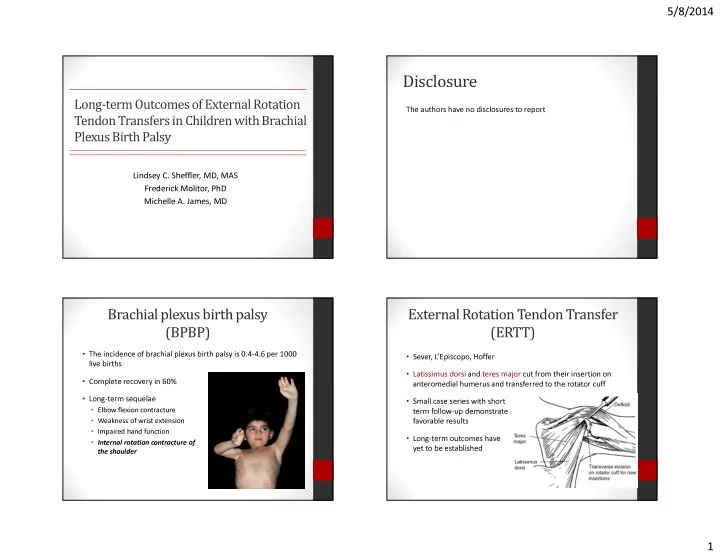

5/8/2014 Disclosure Long-term Outcomes of External Rotation The authors have no disclosures to report Tendon Transfers in Children with Brachial Plexus Birth Palsy Lindsey C. Sheffler, MD, MAS Frederick Molitor, PhD Michelle A. James, MD Brachial plexus birth palsy External Rotation Tendon Transfer (BPBP) (ERTT) • The incidence of brachial plexus birth palsy is 0.4-4.6 per 1000 • Sever, L’Episcopo, Hoffer live births • Latissimus dorsi and teres major cut from their insertion on • Complete recovery in 60% anteromedial humerus and transferred to the rotator cuff • Long-term sequelae • Small case series with short • Elbow flexion contracture term follow-up demonstrate • Weakness of wrist extension favorable results • Impaired hand function • Long-term outcomes have • Internal rotation contracture of yet to be established the shoulder 1
5/8/2014 Study Design Specific Aims • Prospective, longitudinal case series 1) To determine if ERTT improves ER and abduction initially • 139 children undergoing ERTT (one surgeon) at Shriners Hospital (within the first post-operative year) between 1994 and 2007 • 116 included in analysis (>2 yr f/u) 2) To determine if gains in ER and/or abduction are maintained over time • Shoulder ER and abduction were measured pre-op, post-op and yearly 3) To evaluate predictive factors of outcomes (age at the Statistical Analysis (SPSS) time of surgery, gender, subscapularis and/or pectoralis • Paired t-test release) • Linear mixed modeling • Significance criterion p<0.05 Results Study Design (Specific Aim #1 –Initial gains) Pre-op Post-op P-value Table 1: Demographic Characteristics • Initial post-operative ROM ROM Variable N (%) abduction improved by 28 (deg) (deg) Total 116 degrees (p<0.001) Abduction Median age at surgery (yr) 5.3 (2-13) All subjects 97.1 125.3 <0.001 • Initial post-operative ER Median follow-up (yr) 7 (2-13) Pectoralis release 99.2 126.8 <0.001 improved by 41 degrees Gender Subscapularis release 96.3 127.5 <0.001 (p<0.001) Male 49 (42) Both released 95.6 120.9 <0.01 Female 67 (58) No releases 95 122 <0.001 • Improvements were Narakas Classification ER statistically significant I (C5-6) 63 (54) All subjects 13.6 54.8 <0.001 whether or not the pectoralis II (C5-7) 33 (28) and/or the subscapularis were Pectoralis release 8.0 49.9 <0.001 III (global palsy) 21 (18) released Subscapularis release 13.8 56.3 <0.001 Pectoralis release 84 (72) Both released 13.5 54.3 <0.001 Subscapularis release 17 (15) No releases 30.2 67.1 <0.001 2
5/8/2014 Results Results (Specific Aim #2 –Gains over time) (Specific Aim #3 –predictive factors) 50 116 • There were no statistically significant difference in Change in ROM (degrees) 103 95 62 40 55 outcomes for patients who underwent pectoralis and/or 56 17 48 subscapularis releases 12 30 9 30 43 27 20 • Increased age at the time of surgery was predictive of 10 decreased gains in abduction and ER (correlation coefficient -0.22) 0 -10 • Gender and Narakas classification were not predictive of ER Abduction Time (years) outcome • Gains in ROM declined over time but was statistically significant (p<0.05) through 8 years of follow-up Conclusions Acknowledgements • Largest case series to date to evaluate long-term outcomes of ERTT • Shriners Hospital for Children, Northern California • Michelle A. James, MD • Aim #1: ERTT improves both abduction and ER in the initial post- • Frederick Molitor, PhD operative period • Anita Bagley, PhD • Medical Records Department • Aim # 2: Gains in abduction and ER decrease over time but remain • Occupational Therapy Department statistically significant through 8 years of follow-up • Aim #3: Additional releases are not predictive of outcomes. • The patients and their families Increased age at the time of surgery is predictive of decreased gains in ER and abduction • New surgical techniques may improve initial and long-term outcomes of children with BPBP and an internal rotation shoulder contracture 3
Recommend
More recommend